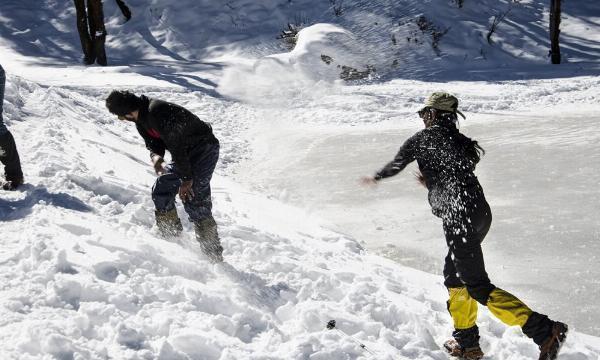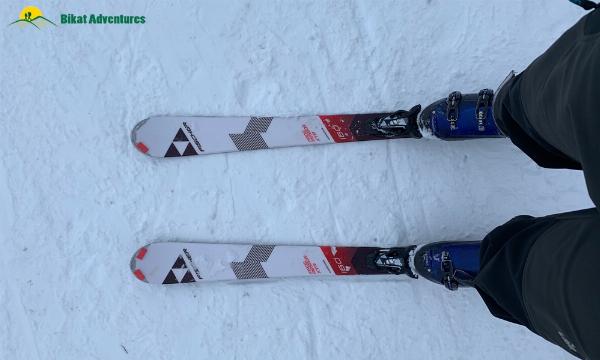Complete Kedarkantha Trek Guide 2024: Tips, Itinerary and More

The Kedarkantha trek in Uttarakhand's Govind Pashu Vihar National Park beckons adventurers with its captivating summit climb and stunning Himalayan vistas, making it one of the most popular treks in India. This 6-day, 20-25 kilometer expedition presents a rewarding challenge for both seasoned trekkers and beginners, offering a panoramic view of the upper Himalayas from the summit.
As you embark on the Kedarkantha trek, you'll traverse through diverse forests and clearings, culminating in a thrilling, steep ascent to the summit. Along the way, you'll encounter well-marked trails, gradual ascents, and strategically placed campsites, ensuring a safe and enjoyable journey. Whether you opt for a Kedarkantha trek package or plan your own itinerary, thorough preparation, including acclimatization and proper gear, is key to embracing the incredible beauty of this Himalayan adventure.
Overview of Kedarkantha Trek
The Kedarkantha trek, located in Govind Pashu Vihar National Park in Uttarakhand, is a 6-day expedition that covers a distance of approximately 20-25 kilometers. It is one of the most popular treks in India, attracting both seasoned trekkers and beginners alike.
Location
Kedarkantha is situated in the Govind Pashu Vihar National Park in Uttarakhand, close to the popular Govind Wildlife Sanctuary. The trek offers stunning views of the upper Himalayas, including peaks like Swargarohini, Bandarpoonch, Black Peak, and Ranglana in the Yamunotri and Gangotri ranges.
Difficulty Level
The Kedarkantha trek is considered a moderate trek, making it suitable for beginners looking to experience trekking in the Indian Himalayas. It is rated as an Easy-Moderate or Level 2 trek, with some challenging sections, particularly during the summit climb. While the trek involves steady climbs and gains in altitude, it is generally well-defined and not overly technical, making it manageable for those with a reasonable level of fitness.
Altitude
The highest point on the Kedarkantha trek is the Kedarkantha peak itself, which stands at an altitude of approximately 12,500 feet or 3,810 meters. Trekkers start from a lower altitude of around 6,500 feet and gradually gain altitude over the course of three days, reaching the summit on the fourth day.
Trek Duration
The Kedarkantha trek typically takes 5-6 days to complete, including travel days from Dehradun to the base camp and back. The trek itself spans a duration of around 5 days, covering a total distance of approximately 20 kilometers. This moderate pace allows for proper acclimatization, making it suitable for beginners.
Best Time to Visit
The best time to embark on the Kedarkantha trek is from December to April, during the winter season, when the trail is blanketed in pristine snow, creating a breathtaking winter wonderland in the Himalayas. This period offers the most enchanting experience, with the landscape covered in a pristine white blanket, making it an ideal time for trekkers seeking a winter adventure.
Seasonal Variations
Summer (April - June)
During the summer months, the Kedarkantha trek offers a lush green landscape with a variety of flowers blooming throughout the trek. April sees the remaining snow cover from the winters melt away, revealing a wonderful green expanse and colorful flowers. Under the dense forest cover of oak and pine, the trek route gently winds up to the waving waters of the Juda ka Taalab Lake. Temperatures range from around 6°C at night to about 20°C during the day.
Monsoon (July - September)
The region receives ample rainfall during the monsoon months, which can sometimes make trekking challenging. However, for adventure seekers willing to brave the elements, the trek offers a completely different experience. You'll be trekking in the rain, with grey and white clouds flowing in and out, and numerous waterfalls emerging due to the rains, adding to the scenic beauty. It's essential to carry waterproof gear and extra warm clothing, as the nights can be cold.
Autumn (October - November)
In autumn, the leaves start to turn dry and fall off, and the color of the meadows changes from green to brown, providing a distinct experience. For beginners, the autumn months are ideal for trekking, as the weather is pleasant, and the views of the Himalayas are majestic. Temperatures range from a minimum of 2°C to a maximum of 15°C during the day.
Winter (December - March)
The Kedarkantha trek is perhaps one of the best winter treks in the Himalayas, with the entire route and surroundings covered in a thick layer of fresh white snow. This region of the Himalayas receives early snowfall due to the confluence of different Himalayan ranges, and the quality of snow is excellent, making it a wonderful ski destination as well. The view of a snow-covered forest is surreal and dreamy, keeping you excited throughout the trek. Temperatures can drop as low as -10°C, adding to the thrill of being on one of the best winter treks in the Himalayas.
Weather Conditions
December is a popular month for the Kedarkantha trek, as a fresh snowfall can make your trek truly memorable. Frequent snowfall in January can sometimes make the climb challenging, but it adds to the adventure and thrill. The Kedarkantha trek in March is still a viable option, as snow remains until April, providing a snowy white beauty and enthralling views. However, it's essential to carry heavy woolen clothes, as temperatures remain chillingly cold from evening until the sunny morning.
Detailed Day-by-Day Itinerary
Day 1: Arrival at Sankri
The Kedarkantha trek starts from the quaint village of Sankri in Uttarakhand located at a height of 6,000 feet. Leave Dehradun early in the morning (6 AM) and reach Sankri by evening to catch the beautiful sunset from this quaint little village steeped in natural beauty. This also gives you ample time to do some last-minute preparations and get some good rest before starting the trek the next day.
Day 2: Sankri to Juda ka Talab
A roughly 5 km trail from the base camp through green meadows and thick pine and oak forests takes you to the picture-perfect Juda Ka Talab campsite. Juda Ka Talab, as the name suggests, is a serene frozen lake which once used to be two lakes but has now conjoined as one. The total trek distance is approximately 20-22 km.
Day 3: Juda ka Talab to Kedarkantha Base Camp
From Juda Ka Talab, a 4 km trek initially through thick pine forests later opens up to lofty mountain views leading you to the Kedarkantha Base Camp located at 11,150 feet. From here, one can enjoy panoramic views of the surrounding snow-clad peaks including Bandarpoonch, Swargarohini, Kala Nag, and Ranglana to name a few. The Kedarkantha peak is also clearly visible from here.
Day 4: Base Camp to Kedarkantha Summit and back to Sankri
The Kedarkantha summit, marked by a Trishul pointing to the sky, is around 2 hours away from the base camp and can be reached through several routes. It is advisable to start the trek before dawn (as early as 3 AM) in order to catch the mesmerizing sunrise (usually around 7 AM) from atop the peak. Although the trail starts off with a gradual ascend, as you get closer to the peak, the trail becomes more challenging with almost 80-degree inclines at a few stretches.
Apart from the breathtaking sunrise, the Kedarkantha summit offers 360-degree views of the surrounding Himalayan ranges including Gangotri, Yamunotri, Chanshil Pass, and Kinnaur Kailash ranges. From the summit, descend back to the Kedarkantha base camp and further down towards the Hargaon campsite.
Day 5: Departure from Sankri
The trail from Hargaon to Sankri is well-marked along a stone-paved route and takes relatively less time owing to the descent. You also get some splendid views of the Har ki Dun valley along the way. Once back at Sankri, you can either choose to spend the rest of the day at Sankri and explore the beautiful Himalayan village or head back to Dehradun the same day provided you came by your own transport or private cab.
Essential Tips and Preparation
Packing List
When embarking on the Kedarkantha trek, it's crucial to pack the right gear and essentials to ensure a safe and comfortable journey. Carrying an original and valid photo identity proof is mandatory for any trek in India, as it may be required at checkposts and campsites. A backpack with a capacity of 60-70 liters, featuring a good hip belt, adjustable straps, and a ventilated back panel, is essential for carrying your belongings.
Proper trekking shoes with waterproof, sturdy construction, good grip, and ankle support are a must-have. Trekking poles can greatly improve stability, reduce strain on the knees, and aid in propelling forward. A headlamp with different lighting modes, brightness settings, and a red light mode is invaluable for hands-free illumination at camp.
Protect your eyes from the harsh Himalayan sun with polarized, wrap-around sunglasses designed for outdoor activities. A well-stocked first aid kit, including bandages, antiseptic creams, pain relief sprays, blister care supplies, and essential medications, can be a lifesaver in the mountains.
Pack a waterproof and breathable rain jacket and pants with taped seams, hoods, and adjustable hems to shield you from the elements. A removable rain cover for your backpack is also recommended. Carry a compact 15-20 liter day pack for summit attempts and day hikes, and gaiters to prevent debris from entering your trekking shoes.
Fitness Requirements
Proper physical fitness is crucial for tackling the Kedarkantha trek's challenges. Gradual acclimatization to high altitudes is essential, as acute mountain sickness (AMS) can occur above 10,000 feet. Avoid going directly to high altitudes, and be prepared to descend if you experience symptoms like dizziness, headaches, or AMS.
Consult a doctor about preventive AMS medications, which can help mitigate the effects of altitude sickness. Staying hydrated, avoiding overexertion, and maintaining proper body warmth are also vital for better acclimatization.
To prepare for the trek, consider following a fitness routine tailored to the difficulty level of the Kedarkantha trek. Gradually increase your endurance by running or hiking, and incorporate strength training exercises to build stamina for the ascents and descents.
Altitude Sickness Tips
Altitude sickness can affect even experienced trekkers at relatively lower altitudes like 11,000 feet. Symptoms like nausea, vomiting, and indigestion should not be ignored, as they may indicate altitude sickness. Adequate rest is crucial, as the rigors of trekking and rapid altitude gain can increase susceptibility to AMS.
Being on a preventive course of Diamox can help mitigate the chances of altitude sickness. In severe cases, Dexamethasone, a steroid, can provide a temporary boost, allowing for a safe descent. However, it should only be used in rare cases and under proper guidance.
Monitoring for signs of ataxia, such as difficulty walking in a straight line, is essential. If symptoms persist or worsen, descending to a lower altitude is the safest course of action.
Conclusion
The Kedarkantha trek in Uttarakhand's Govind Pashu Vihar National Park offers an invigorating and visually stunning experience. As you embark on this moderate yet rewarding trek, you'll traverse through pristine forests, frozen lakes, and challenging ascents, culminating in breathtaking panoramic views from the Kedarkantha peak. Proper preparation, acclimatization, and fitness are essential for a safe and memorable journey. Contact Bikat Adventures for more details on booking a Kedarkantha trek package tailored to your preferences.
With its captivating scenery, diverse terrain, and accessible difficulty level, the Kedarkantha trek is a must-visit destination for both seasoned trekkers and beginners seeking an authentic Himalayan adventure. By following the detailed itinerary, packing essentials, and heeding the expert tips provided in this guide, you'll be well-equipped to conquer the Kedarkantha peak and create lasting memories amidst the majestic Himalayas.
FAQs
1. How long does it typically take to complete the Kedarkantha Trek? The Kedarkantha Trek, which starts from Sankri and spans 22 kilometers, usually takes 4 days to complete. This includes approximately two and a half days for the ascent and one and a half days for the descent. Additionally, one day is required for travel to Sankri from Dehradun and another day for the return, totaling 6 days for the entire trip.
2. Is it necessary to have a guide for the Kedarkantha Trek? Yes, having a guide for the Kedarkantha Trek is mandatory. Trekkers are not permitted to trek without a guide. Guides can be easily found in Sankri village, and they also assist with obtaining necessary permissions from the forest department.
3. What should I pack and how should I prepare for the Kedarkantha Trek? To prepare for the Kedarkantha Trek, ensure you have a well-equipped backpack, sturdy trekking shoes, warm clothing suitable for cold weather, rain gear, a sleeping bag, a headlamp, and a first aid kit. It is also advisable to bring trekking poles and a water bottle for convenience and hydration.
4. Which route should I take for the best experience on the Kedarkantha Trek? The best routes for the Kedarkantha Trek include:
The Sankri Route via Juda Ka Talab
The Kotgaon Route
The Gaichwan Route Each of these routes offers unique experiences and scenic beauty, so you can choose based on your preferences and fitness level.
💡 Book Now: 7838148127
Note: IndiBlogHub features both user-submitted and editorial content. We do not verify third-party contributions. Read our Disclaimer and Privacy Policyfor details.




